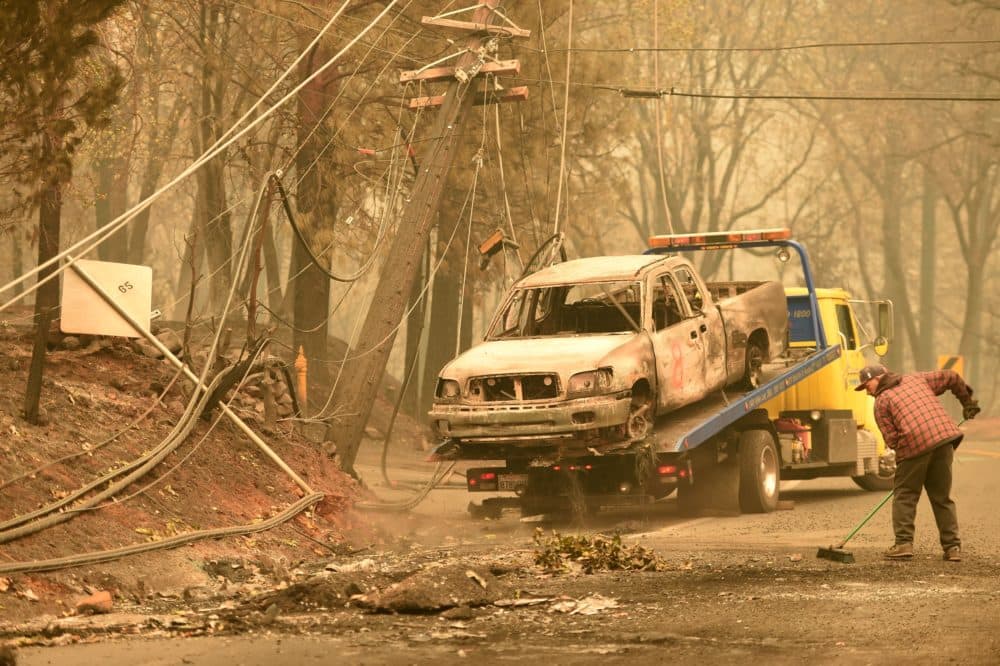Advertisement
Camp Fire: Local Official Describes Devastation In Northern California's Butte County
Resume
The Camp Fire in Northern California is the deadliest wildfire in state history.
The fire tore through the town of Paradise in Butte County on Thursday, where dozens of people are still missing. More than 6,400 homes were destroyed, forcing residents to seek shelter for an unknown length of time.
"The community has been through a lot. It's kind of surreal, honestly," says Casey Hatcher, economic and community development manager for Butte County. "The [Cal Fire] Incident Management Team put out some information ... where people could start to look up and see the status of their homes. A lot of people that had thought that their homes were lost have some of that confirmed. Others are still waiting.
"People are anxious, but I think it's really just kind of starting to settle."
Poor air quality is also significantly impacting the area, Hatcher tells Here & Now's Elise Hu, prompting the county to distribute smoke masks that filter out harmful particulates.
"People really should be wearing those if they're outside, and frankly, I'm sitting inside of a room and I can see the layer of smoke up on the ceiling," Hatcher says. "It just really is socked into the valley here."
Interview Highlights
On where people who have lost their homes or have been displaced have gone
"The county has worked to set up shelters, so we have a number of different shelters set up within the county. Our other surrounding counties have been so amazing to help and set up shelters in their communities. So a lot of folks, more than a thousand people, have gone into the shelters. But we're looking at tens of thousands of people that are evacuated here. People are sleeping on couches, staying with friends, lots of people have left the area. Where people live — in the short term and frankly in the long term — is still something that we're working out, because there's so many homes lost in this fire."
"We're certainly still in the incident, but we know we're going to be able to recover from this."
Casey Hatcher
On options being considered to house people and help them recover
"There's still certainly an active fire going on, and [there are] many, many folks managing the response — both from the Cal Fire Incident Management Team, the sheriff's office, the county, the town of Paradise and all of our agency partners. But we are now, with the federal declaration, really switching into recovery mode and putting together one of the task forces that will look at ... housing: What do we do in the short term? What do we do ... in the medium term, and then how do we help people rebuild? There will potentially be a shelter component where people can stay, and we're still forming up what that's going to look like. Where do we have capacity for that within our community? Does that mean something similar to what you've seen in other disasters, like trailers on open ground? Does that mean a facility that we put up to house people? Really, what does that look like, and we're starting to form those ideas now."
On air quality in the area
"It's not good. Certainly, our public health department continues to let people know, and our local stations have done really just an amazing job of helping people understand the air quality. We've distributed masks, N95 masks, to a number of locations: grocery stores, major outlets, to all of the shelters. ...
"As the winds have died down, [the smoke is] not being pushed out, and we really want to make sure people are wearing those masks ... specifically if they're in sensitive groups. But it's really ... the air quality is really, really poor, and we want to make sure everyone gets a mask and just stays aware of the symptoms that they're feeling, whether that's headache or fatigue, make sure you're taking care to protect yourself from the smoke."
On how a community recovers from something like this
"Well I think that's a good question, and I think it's one that other communities have certainly had to grapple with, and we're still trying to figure that out. But the thing that we have seen more than anything else is that everyone has really come together. You just can't imagine the outpouring of support that we have received from folks within our own county directly, adjacent to us from other counties that are probably still recovering from recent fires, whether it's Shasta County or Sonoma County, who have just stepped up and said, 'We want to come help. We'll be there.' It really gives you the feeling that you can do it, that there's a path to recovery here, and we've started down that. We're certainly still in the incident, but we know we're going to be able to recover from this."
Julia Corcoran produced and edited this interview for broadcast. Jack Mitchell adapted it for the web.
This segment aired on November 13, 2018.